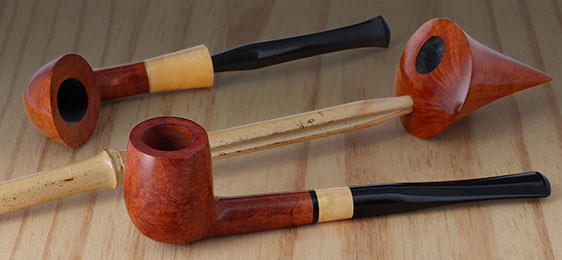

Here is a quick pic of my work table set up to apply the coating to today’s patient – a Patent Era Brigham 3-Dot 390 shape Canadian. After curing, your pipe is ready to go!.The bowl coating will cure smooth and hard. Dump out the excess charcoal powder, remove the pipe cleaner from the stem.This gives time for a layer of charcoal powder to be absorbed by the syrup. Allow the pipe to sit for an hour or more.Pour activated charcoal powder into the bowl right up to the rim.Wipe maple syrup around the inside surfaces of the bowl.Insert a pipe cleaner in the stem of the pipe to keep the airway open.If they open up down the road, I will seal them with JB Weld, which dries/cures safe and inert. As I said before, the fissures are all tight, without any indication of movement, so they should be ok once covered with the bowl coating. I was warned off about using CA glue inside the bowl, so these were left alone. They’re nearly invisible in the finished pipe. CA glue was flowed into these and sanded smooth after curing. There were 3 cracks that extended up onto the rim of the pipe. Here are a few close-up pics of the pipe bowl after cleaning/reaming.

I assume the cracks are evidence of heat stress in the wood, caused simply through smoking the pipe, if perhaps a little too fiercely. I originally posted my hunt for a bowl coating that worked after I bought an estate pipe that, after a proper cleaning and reaming, turned out to have many tight, thin fissures/cracks that followed the grain on the inside of the bowl. It’s about as simple as you can get – just 2 ingredients: maple syrup and activated charcoal powder. So that leads me to this bowl coating process shared with me by a fellow member of the Brothers of Briar pipe forum (thanks Riff Raff!).

I prefer to allow the briar to expand and contract naturally as it heats and cools through use. I also tend towards coatings that are not water or air tight, for much the same reason I avoid lacquer or other barrier type finishes on the outside of a pipe. I personally tend towards the former position, namely that a bowl coating can be useful to help protect repaired areas inside the pipe bowl until a decent layer of new cake is formed through use. And some pipers are dead set against bowl coatings of any kind, arguing that they stop the briar from “breathing” and thus could actually cause cracks from heat stress.
#How to make a smoking pipe out of wood cracked#
Sometimes a bowl coating is used to repair a cracked or otherwise damaged pipe bowl. Some coatings are factory-applied to new pipes in the belief that they help protect the briar wood of the bowl from burnouts and assist in the formation of cake – that even layer of hard ashy stuff that insulates the briar from the heat of the burning tobacco. Pipe makers and restorers use various types of bowl coatings for a variety of reasons.


 0 kommentar(er)
0 kommentar(er)
